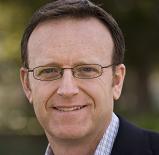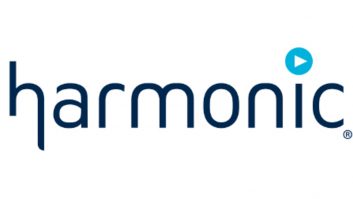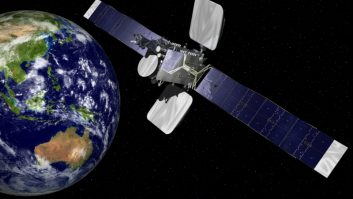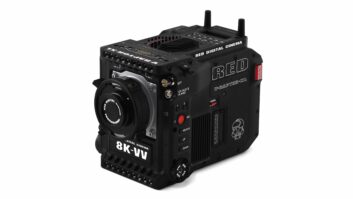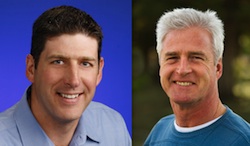
One of the biggest business stories this year was the acquisition of Omneon by Harmonic. With the deal now almost complete – current estimates are that it will close at the end of September – Dick Hobbs spoke to the VPs of Development and Marketing of each company: Geoff Stedman of Omneon (left) and David Price of Harmonic.
We were seeing fundamental shifts in the marketplace which meant we had to grow more mass,” says David Price. “We needed to make the big jump. We looked at a lot of companies, but Omneon was exactly what we were looking for.
“It moves the needle – we will be a half a billion dollar company by next year,” he adds. “That gives us the credibility you need when you are asking people to invest in technology platforms.”
Harmonic was founded in 1988 to develop digital delivery products, at around the time that cable operators in the US were becoming MSOs, and fibre was being used to get more bandwidth. Since going public in 1995 the company has used strategic acquisitions – from Divicom 10 years ago to Scopus last year – as a way to add specific skills as well as growing bulk.
Omneon Video Networks started in 1998, with the intention of creating a new style of server and network – “connect everything over 1394” is how Geoff Stedman summarises it. From the first shipped product in 2001 those early attributes of scalable, modular, high availability systems have proved popular.
Today both companies are successful, cash positive and with good reputations in the market. So what is the benefit in the acquisition? It is a big financial commitment for Harmonic: $162 million in cash and $150 million in stock.
“This is two number ones coming together,” Price says. “We have a complete focus on video with no interest in other products. People will perceive us as market leaders.”
For Geoff Stedman of Omneon, “this was a great opportunity to partner with a company that is complementary. Harmonic is good in streams, Omneon is good in files. We now have the opportunity to integrate, and over time there will be opportunities to integrate in novel ways.
“That is why you do these things – to make better products,” he asserts.
@subhead:Sunnyvale, California
@copy:In practical terms, while it is an acquisition by Harmonic, both brands will stay, “for some time,” according to Harmonic’s Price. “We are actively going to manage the brands,” adds Stedman.
Fortuitously, both company headquarters are in Sunnyvale, California. Before the acquisition Harmonic was in the process of moving into a new building which is big enough for both teams, so in due course Omneon will move in, too.
Both men make the point that the two companies share a common culture, not just in the technologies they pursue but in quality, support and customer relations. According to Price “we could quickly talk about ‘us’.” They feel that the marriage will work well.
Harmonic acknowledges that it has much to learn from Omneon, not least in the way its products are sold and distributed. 67% of Omneon revenue went through the partner programme as against only 31% of Harmonic, so there is interest in moving towards the Omneon sales structure.
“We would never open a sales office without support,” says Stedman, underlining the fact that Omneon products tend to be part of a larger solution. “You have to have system design before you can sell into a region.”
“We do not want bland harmonisation,” emphasises Price. “In the end it is an acquisition, but we are looking to get the best possible results. And the shared culture makes assimilation possible.”
The joint company will have more than 450 engineers, many in Sunnyvale but with Harmonic R & D centres in Israel, Hong Kong and Beaverton and algorithm research in New York and India.
“Both companies have been focussed on building infrastructure, the enabling platform that allows our customers to do what they need with the tools that they want,” Stedman says. “Both have been focussed on what we see are the core issues: video quality, speed, productivity and low latency.
“We want to provide the best infrastructure, no more, no less,” he continues. “We are not like Grass Valley or Harris who want to sell you everything, but we are looking to put products together in new ways to streamline workflows. Together we can tackle issues like codec concatenation and its impact on quality. The organisations will still be independent but grouped together.”
David Price adds a note of realism about the challenges of bringing two organisations together. “The key is that the same people will be in place,” he says. “They like working with the people they know, so we cannot force the pace of integration. But we suspect that a lot of good things will come from chatting over the same coffee pot.”
Talking to David Price and Geoff Stedman, it is clear that both are extremely positive and optimistic about the acquisition. They argue consistently that this is not just about finance, although the critical mass is seen as important in an economic environment where further consolidation is certain.
“This deal is not being driven by cost synergies,” Stedman concludes. “This is not to create more profit. For Omneon, it is a great opportunity to partner with a company that is complementary.”
Price adds, “when people hear the word Omneon they will think about Harmonic, and vice versa. And know they are both great brands.”
